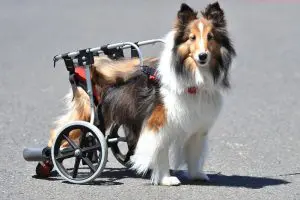Arthritis in pets, particularly dogs and cats, is a common condition that causes pain and stiffness in the joints. It’s often a progressive disease, meaning it worsens over time, and can significantly impact a pet’s quality of life.
Fortunately, there are ways to manage the disease and alleviate your pet’s pain, such as proper weight management, limiting strenuous activity, or giving your four-legged companion Carprofen for dogs. In addition to learning about the causes and most common symptoms of arthritis, this article will provide you with information on the most effective treatment methods. Continue reading to learn everything you need to know about arthritis in dogs.
Symptoms of Arthritis in Pets: Cats and Dogs
The symptoms of arthritis in dogs can be very mild or severe. They may include:
- Limping
- Reluctance to climb stairs or jump
- Abnormal gait with stiffness
- Reduced ability to play, exercise, or walk for extended periods of time
- Abnormal or increased sensitivity, especially in cold weather or after exercise
- Abdominal soreness, which is known as “bunny-hopping” when the pet is resting in a crouched position
- Discomfort when turning, jumping, or changing direction
- Chronic pain when moving or eating
However, some pets do not have any noticeable symptoms of arthritis.
Causes of Arthritis
There are many causes of arthritis in pets. Some are related to genetics, while others are related to the environment. Pet owners should be aware of these factors and preventative measures they can take to reduce the risk of arthritis in their pets.
Prevalence in specific animals
- Dogs:
- It’s estimated that roughly 1 in 5 adult dogs in the U.S. suffer from joint pain and mobility issues due to arthritis.
- As many as 90% of older dogs (over 8 years) may experience signs of OA.
- Certain breeds, often larger ones, are at a higher risk due to factors like genetics, hip dysplasia (common in Labradors, German Shepherds, and Golden Retrievers) and other developmental joint diseases like elbow dysplasia or patellar luxation.
- Cats:
- Arthritis is also common in cats, though their natural ability to hide pain can make it harder for owners to spot early on.
- Research suggests approximately 60% of cats over the age of six and 90% of cats over 12 years old suffer from some degree of degenerative joint disease.
- Some breeds, like Maine Coons and Persians, are at a higher risk for joint-related issues.
Nutritional Factors
Pets with dietary deficiencies are more prone to developing arthritis. For example, pets with a calcium deficiency are more likely to develop osteoarthritis than pets with normal calcium levels. Symptoms include hip dysplasia, joint pain, and reluctance to exercise. It’s important to monitor your pet’s diet and ensure that its food is high-quality and meets his nutritional needs. If you aren’t sure what your pet should eat, speak to a professional veterinarian or a veterinary nutritionist.
Environmental Factors
Pets who are exposed to extreme heat and cold have an increased risk of developing arthritis. For example, dogs with severe hip dysplasia may be less likely to develop arthritis if they live in a warmer climate. In this case, the hormone that causes inflammation is absorbed into the body more quickly in cold weather, causing joint pain.
Preventing and Managing Arthritis
There are several things you can do to prevent and manage arthritis in your pet.
- Provide Quality Nutrition: Senior pets need good nutrition to maintain good bone and joint health. A holistic diet with plenty of omega fatty acids and vitamin E can be extremely beneficial in preventing and slowing the progression of arthritis.
- Weight Management: Obesity is another risk factor for arthritis in pets. Maintaining a healthy weight is an important part of managing arthritis in pets and

- Pain Relief: Your veterinarian can prescribe pain medication or provide recommendations on alternative methods of pain relief for your dog. These methods include acupuncture, supplements, and physical therapy.
- Surgery: In some cases, surgery can help relieve pain due to arthritis in dogs. However, surgery is only recommended as a last resort because it has potential side effects and complications.
- Preventative Measures: Arthritis cannot be prevented entirely, but there are ways to prevent the onset of arthritis in dogs. For example, hip dysplasia can be prevented by controlling the amount of exercise your dog has. Dogs that are genetically predisposed to hip dysplasia should be limited to light activity, such as walking. Dogs that are older than five years should also take it easy on their joints by limiting strenuous activity, such as running or jumping.
Home Care for Arthritis
The following home care techniques can help manage arthritis in dogs.
- Massage Therapy: Massage therapy can reduce inflammation and ease pain due to arthritis in pets. The massage can stimulate blood flow to the affected area, which helps improve circulation and reduce pain. Ask your veterinarian for specific massage techniques that will work best for your pet. You should also try other types of soothing massage techniques, such as acupressure or petting therapy.
- Acupuncture: Acupuncture involves inserting needles into the skin at certain points on the body to stimulate blood flow and promote healing. Studies show that acupuncture reduces pain due to arthritis in pets, although the mechanism is unclear. Acupuncture can also be used alongside other treatments like physiotherapy to reduce pain and improve mobility without the use of traditional drugs.
- Soft Cushioning: If your pet is uncomfortable, a soft cushion or bed can be a great way to keep it comfortable and relieved from pain. Pillows and blankets made from memory foam are ideal because they have the right amount of firmness and give support to aching joints.
- Alternative Therapy: Herbal remedies, acupuncture, and supplements can all be effective ways to relieve pain and inflammation due to arthritis in pets. Speak to your veterinarian about the best options for your particular situation.
In many cases, arthritis can be managed with these treatments and techniques. However, if your pet’s symptoms worsen or it experiences new symptoms, speak with your veterinarian for additional treatment options and further instructions.
In Conclusion
Arthritis in pets can be managed with the right care and medications. However, your pet should see a veterinarian right away if it starts to experience pain or discomfort. If you notice that your pet is experiencing any of the above symptoms, schedule an appointment with your veterinarian right away. Together, you can determine whether your dog has arthritis and how to best manage the disease.


















